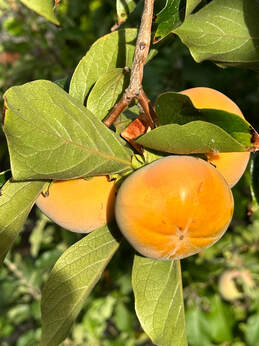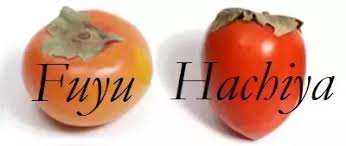Nobody bakes Persimmon Bread in the spring,
Or in the summer for that matter.
Persimmons are autumn’s glorious gift,
The last free fruit that ripens when it wishes
When the maple leaves, persimmons’ ancient twin,
Turn the smoky sweet orange hue
Of dawn over the foothills.
You can’t buy Persimmon Bread in the grocery store,
Packaged in a box as a mix, powdered with plenty of preservatives,
Or frozen in aluminum with a time stamp on the wrapper.
If you want Persimmon Bread, you have to make it yourself,
You have to know somebody,
And you have to live in the right place.
Persimmons thrive in Wakayama,
But they also grow on gnarly old trees in the back yards
Of your buddies who still live in East San Jose.
They’ll give you some when the delicate orbs are ripe and sweet,
And you’ll give them a loaf when the baking is done.
You’ll need honey, another old friend, golden and lovely,
Like autumn sunlight through the leaves.
And some spices—a little nutmeg, maybe some ginger,
But go easy on the cloves, as you don’t want to overpower
The precious persimmons’ delicate umami fragrance.
Yes, I have the recipe, and I might share it when I’m convinced
That you will give the persimmons, who are giving their all to you,
The respect, reverence and gratitude they deserve.
In her September 2023 blog, Kathleen shared a very special recipe for Autumn Fruit Upside Down Cake, offering options for Quince, Apple or Pear Cake. Another delicious, late-ripening fruit is the persimmon, sweet and luscious when the chilly days of November arrive. When we think of November, Thanksgiving is the first image that comes to mind (unless we live in Canada, where Thanksgiving is celebrated on October 9.) As I think about Thanksgiving this year, beautiful orange persimmons enter my imagination.
As my poem about Persimmon Bread points out, persimmons ripen in late autumn and are not as widely cultivated as a commercial crop as apples and pears, yet they are tasty and versatile, adding color, fragrance and a subtle, tart flavor to both savory and sweet dishes. Persimmons originated in China and are known today by the scientific name, Diospyros kaki, using the Japanese word, kaki for persimmons. The persimmon tree is in fact related to ebony, a tree famous for its elegant dark wood. This fruit is extremely popular in Japan, where it was introduced from China in the Seventh Century. Japanese artists traditionally paint this elegant, light coral colored fruit in compositions evocative of autumn. And the famous Japanese former Samurai and poet, Masaoka Shiki (1807-1902,) wrote numerous haiku extolling his love for this delicious fruit. Indeed, eating persimmons was Shiki’s greatest consolation while he was tragically dying of tuberculosis.
In this persimmon-inspired haiku, Shiki compares and contrasts the sharp, sweet experience of biting into a persimmon with the mellow sound of the bell at Horyuji Temple in Nara,
famous for its persimmon orchards. Janine Beichman, the translator and author of the book, Masaoka Shiki, included the following comment about the meaning of this memorable poem, suggesting “…on a more metaphysical level, the mortal moment of one human being biting into a piece of fruit and the broad, eternal expanse of time symbolized by the bell of the ancient temple.”
Persimmons did not find their way to California and southern Europe until the 1800s. China continues to produce 75percent of the world’s persimmons, and in the United States, California and Florida are the largest producers of this lovely fruit. There are two primary varieties of persimmons, Hachiya and Fuyu, both identified by their Japanese names. Hachiya persimmons are heart shaped with a pointed bottom. They contain large amounts of tannin and should not be eaten until they are fully ripe to avoid digestive problems. Ripe Hachiyas become almost liquid and can easily be pureed to be baked into Persimmon Bread, Persimmon Pudding and Persimmon Cookies. Fuyu persimmons, which resemble a flat tomato, can be eaten raw while they are still firm.
There is also an indigenous American persimmon with its own scientific name, Diospyros virginiana, though this strain of persimmon actually originated in Kentucky. American persimmons are much smaller than those of Asian origin and are reputed to be very sweet, but they also cannot be eaten when unripe because of the high tannin content. American persimmons are not grown commercially and are only enjoyed by people who can find them in the wild, primarily in the eastern and midwestern areas of the United States, or who have planted trees on their own property. Many Native Americans living in the eastern United States before the Europeans arrived included persimmons in their diet, drying them and preparing them as puddings and breads.
At a recent family gathering in Watsonville, California, my co-author and niece Kathleen Pedulla and I created a simple, seasonal Spinach and Persimmon Salad, using local Fuyus. To make this splendid salad at home, combine a box of baby spinach leaves (I took the time to remove the stems) with sliced toasted almonds, small slices of peeled Fuyu persimmons and a generous helping of bleu cheese. Toss these four ingredients with an easy vinaigrette made from vinegar (or lemon juice,) olive oil, salt and pepper, and perhaps a spoonful of mustard. Your family will be delighted by the intriguing savory and sweet impact of this elegant autumn salad, and it might be fun to include it in this year’s Thanksgiving celebration, as it will not require much of your time as you prepare your family’s traditional meal.
To assist you to reclaim your spirit of gratitude and to plan for your family’s Thanksgiving meal, our website and blogs are here to help. My November 2016 blog features the menu for our family’s traditional Thanksgiving feast and includes the recipes for Cranberry Ginger Sauce, Wild Rice Dressing and Pumpkin Praline Pie. My November 2019 blog, “Festive Fall” offers the recipes for three special additions to the traditional Thanksgiving meal: Mushroom Sage Crostini, Cranberry Curd and Lemon Chess Pie. And as a tonic for that after Thanksgiving exhaustion, our website shares the complete menu for an After Thanksgiving Tea, including cleverly re-purposed leftovers. Check it out in the November calendar section of The Tea Book. But this year, as you may have guessed, I’m sharing the recipe for Persimmon Bread, a glorious addition to the dessert table along with the traditional Pumpkin Pies.
- 3 ½ cups all-purpose flour
- 1 ½ teaspoons kosher salt
- 2 teaspoons baking soda
- 1 teaspoon nutmeg
- 2 cups sugar
- ½ cup honey
- 1 cup (2 cubes) unsalted butter, melted and cooled
- 4 large eggs, at room temperature and slightly beaten
- 2 cups persimmon puree from approximately 4 squishy soft Hachiya persimmons, skins not included (The juicy pulp can easily be scraped out of the peel.)
- 2 cups toasted chopped almonds
- 1 cup dried sweetened cranberries
- 1 cup chopped pitted dates
- ¼ cup finely chopped candied ginger
- 2/3 cup apple juice (or brewed and cooled rooibos chai tea)
- Cooking spray for the pans
Special Equipment: food processor or blender, extra large mixing bowl, large mixing bowl, glass measuring cup, medium sized mixing bowl, whisk, rubber spatula or wooden spoon, 3 aluminum 8”x4” loaf pans or 2 nine-inch loaf pans, bamboo skewer
Makes: Three 8”x4” loaves or two 9” loaves
Preheat oven to 350 degrees F
- Spray the loaf pans with cooking spray and set aside. In a large measuring bowl, prepare and assemble the toasted chopped almonds, chopped candied ginger, cranberries and dates. Stir with a rubber spatula or wooden spoon to combine. Sift the dry ingredients, including the sugar, into an extra-large mixing bowl and set aside. Cut the butter into chunks into a glass measuring cup and microwave at 30-second intervals until melted. Set aside to cool.
- In a medium sized mixing bowl, whisk 4 eggs lightly and set aside. Scrape the pulp away from the skin of 4 or more very ripe Hachiya persimmons until you have 2 cups and puree lightly in a food processor or blender. Add the honey until combined.
- Make a well in the center of the dry ingredients in the extra-large bowl with a wooden spoon or rubber spatula. Stir in the cooled butter, eggs, apple juice and persimmon mixture until combined. Then stir in the dried fruits, almonds and candied ginger until well distributed.
- Pour the batter evenly into the prepared pans and bake in the pre-heated 350-degree oven for approximately 50 minutes for 3 smaller loaves or 1 hour for 2 larger loaves. Test for doneness by inserting a bamboo skewer into the center of each loaf.
- Serve warm with butter or rum raisin ice cream, or cool completely and wrap snugly in plastic wrap, then aluminum foil and freeze.














 RSS Feed
RSS Feed